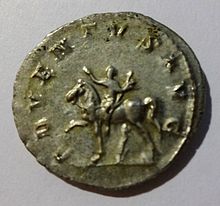Adventus
The term Adventus (from Latin advenire , to arrive , compare also Advent ) describes the arrival of a ruler and the associated ceremony in historical research . The development of the latter term adventus is described using examples from late antiquity to medieval sources for the entry of rulers. The typical Adventus depiction shows the emperor riding on a horse and greeting with one arm raised, while the other arm holds a scepter as a symbol of imperial power.

The ancient form of the entry with the godlike representation of the emperor was the inspiration for the mediaeval symbolism. The ceremony was transferred to the ruler's cult for the political and sacred exaltation of the regent . It took place under strict observance of fixed customs and liturgical forms. In addition, the audience aspect and the associated celebrations were emphasized. Jasper Schenk writes of a "particularly strong emphasis on the festive and solemn character of the rulers' entrances", as was practiced in France, for example.
The mythical origin lies in the triumph of the god Dionysus in Greece , which in ancient times was celebrated in spring. In the course of time the Dionysian component stepped back in favor of the military component, which was consolidated in a state ritual with the triumphs of the Roman emperors .
When triumph went out of fashion in the course of the fourth century , perhaps because of its non-Christian character, the importance of Advent, which was also acceptable to Christians, grew immensely. In late antiquity it was also the emperor's deputy, and the church took it over for bishops and popes. The religious meaning of the medieval ruler's advent and its liturgical design under ecclesiastical influence are based on early Christian ideas influenced by Roman antiquity. At the solemn entry of the ( by definition victorious) late Roman emperor (e.g. Justinian I 559), the Adventus symbolism of the Roman imperial period was repeated, transposed into Christianity.
The rulers (and popes) of the European Middle Ages also adopted Adventus in a slightly modified form. At adventus regis , the ruler could grant an amnesty for criminals or protection for the persecuted. The arrival in a city was divided into a triumphant one, based on an ancient background, and a religious one.
On arrival at a monastery, however, the triumphant part was omitted as a sign of Christian humility . The convent receiving ceremonial based in part on the section 53 of the rule of the order of Benedict of Nursia , which describes the reception ceremony, the guests of a Benedictine is bestowed. However, these provisions were adapted to the higher position of the honored and enriched by liturgical chants in the style of the Introitus . In Carolingian times, some poems were made especially for the reception of a ruler in the monastery, for the first time in 818 by Theodulf von Orléans .
At the beginning the rulers were careful that no one else would receive this honor, but in the late Middle Ages the primacy of the king disappeared.
literature
- Joachim Lehnen: Adventus principis. Investigations into the meaning and the ceremonial of the arrival of the emperor in the cities of the Roman Empire . Lang, Frankfurt am Main 1997, ISBN 3-631-31592-9 .
- Sabine MacCormack: Change and Continuity in Late Antiquity. The Ceremony of Adventus. In: Historia . tape 11 , 1972, p. 721-752 .
- Peter Willmes: The ruler 'Adventus' in the monastery of the early Middle Ages . Wilhelm Fink, Munich 1976, ISBN 3-7705-0993-5 ( online ).
- Gerrit Jasper Schenk: Ceremonial and Politics. Entering rulers in the late medieval empire . Böhlau, Cologne 2003, ISBN 3-412-09002-6 .
- Jörg Traeger : The Pope on horseback. A contribution to the iconography of the papacy (= Munich art historical treatises . Volume I ). Fast u. Steiner, Munich-Zurich 1970, ISBN 3-7954-0450-9 .